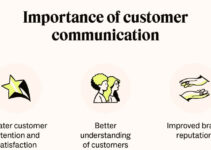Change is inevitable and the only constant towards the growth and progress of businesses and companies. When it happens, it causes a lot of disturbance and disruptions in the market. However, it is possible that the change is the result of growth strategies that you have been devising and implementing to transform your business. The organizational change would only become successful if everyone is on the same page and willing to accept it; it requires you to communicate change, the real challenge. Today, we’ll discuss the top 3 change management communication examples.
While communicating change, some of the key points you should keep in mind are as follows;
- Make sure to employ the right communication channel that is easily accessible to everyone
- Start with discussing the top reasons for change and why they are urgent
- Be real, open, and honest
- Empathize with the emotions of people since it’s a sensitive matter
- Highly advisable that the top management and leadership discuss the vision of the company
- Beware of the direct impact of the change that employees are or would experience them
- Peer-to-peer advocacy and ambassadors program throughout the organization
- Keep in mind the organizational culture and extended network and relationship with employees
Change Curve
Before discussing the change management communication examples, it is important to discuss the “change curve” of psychologist Elisabeth Kubler-Ross. However, the change curve is a great initiating point while devising a successful change management communication plan or roadmap. The change curve goes through the following human emotional stages;
- Shock
- Denial
- Depression
- Engagement
- Experimental
- Decision
- Engagement
Kubler suggests that the management should discuss and communicate the change at every stage with their employees. The communication method and channel should be relevant to the receptive level of employees and the targeted audience. If you push them prematurely to the next stage before they’re fully ready, it reduces your likelihood of achieving the success that you have planned.
If the change is negative or even positive, then it would negatively impact your employees. For instance, when you execute a change process, then it would compel them to get out of their comfort zone and change their yearly developed habits, attitude, and behaviors. In case of a merger or acquisition, it would remove some of the duplicate jobs. Resultantly, it increases the stress level among employees because they’re worrying about losing working colleagues and the survival of their job.
Change Management Communication Examples – Top 3
Some of the top 3 change management communication examples are as follows;
Two-Empty Rows – Ending
An international manufacturing company is conducting an annual sales meeting of 300 employees, it was right after the change and reorganizing period. In order to analyze the pervasive uneasiness of employees, the VP of Sales decided to come to the stage without any promo music or usual fanfare thing; instead, he asked and made the first two rows of chairs and benches to be left empty.
He started the conversation by acknowledging the fear, sadness, and uncertainty among employees. He mentioned how he and other leadership is feeling not good about letting go of some hardworking employees and; the company’s efforts of taking care of them in whatever they could. In short, he acknowledged and validated their feelings and emotions; it explains the initial three stages of the curve (denial, shock, and depression).
After finishing the speech, he requested everyone to step forward one seat to represent their first step to the transition phase. The first row of chairs remained empty, it is a promise to stage three of a new beginning. It boosted the morale of employees and they were willing to learn about the transition phase and their new roles and duties.
Purpose Affirmation – Transition
The international service-providing firm had faced a notorious and publicized incident in one particular department. The incident happened only because a few people didn’t take the proper actions timely, and the result impacted not only one department but the entire organization. Employees cared for the company’s reputation and it started associating with the wrong things. However, some of the employees started looking for other jobs in other organizations.
Communication Campaign
The management and leadership of the company took appropriate and remedial actions to deal with the offense. They realized that their actions were good, but not enough to restore the trust, belief, and faith of employees in the company. However, they came up with a plan of dealing with the issue right away by launching mega strategic changes, starting the communication campaign, and launching the new processes immediately.
They realized the fact that the employees were in the early stages of the change curve; they made the focus of the campaign to remind them how the company and its employees are benefiting the customers. It played a significant role in rebounding and attracting people to the company. In fact, they launched another video campaign to address the concerns of employees and how it is impacting their professional pride and self-esteem.
In the meantime, the company also developed a system of “fail-safe-processes” to avoid either intentional or inadvertent actions. That’s why change management communication is highly important and critical, and it offers a stern warning to follow the standard protocols and process; there would be a zero-tolerance policy if they failed to act on them.
As a restrictive measure, the company started the “control system” to make sure to the employees that nothing would stop them from providing quality service to the employees. They made it clear that their compliance was necessary, but how they presented the case matters and it becomes an expression of shared noble purpose; you do what is right and good for customers. It makes sure that the trouble-causing actions won’t go unchecked.
Not a New Strategy – New Beginning
The most significant factor in implementing and cascading change in the company is to highlight the point that change is not company strategy while discussing the company’s strategy.
A company had gone through a difficult phase, and the new management and leadership decided to transform things and devised a strategy. They decided to make some adjustments to amplify the growth based on the key insights from the initial developmental phase. Their focus was to offer to better experience to the targeted customers and make the company’s operations efficient.
Out of many adjustments, one such adjustment is to revise the company’s communication strategy. They decided that the company’s management and leadership would express the company’s strategy in a lucid and clear manner that is easily memorable. The communication team would make conscious decisions of not overselling and creating hype about the change strategy.
They introduced the “change management light” program, celebrated employees and the current strategy that has made it successful, and presented the updated strategy refreshing its presentation that is memorable, accessible, easy, and simple.
Conclusion: Change Management Communication Examples – Top 3
After an in-depth study of change management communication examples; we have realized that change management communication is highly important for companies. If you are developing a change management communication strategy, then you should keep in mind the abovementioned examples and learn from them.
Ahsan is an accomplished researcher and has a deep insight in worldly life affairs. He goes Live 3 days a week on various social media platforms. Other than research writing, he’s a very interesting person.


